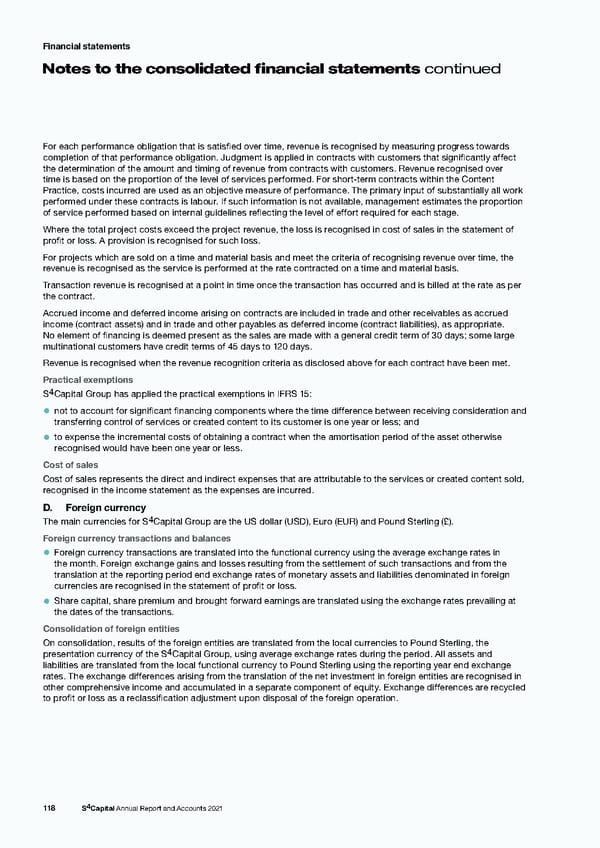Financial statements N otes to the consolidated financial statements continued For each performance obligation that is satisfied over time, revenue is recognised by measuring progress towards completion of that performance obligation. Judgment is applied in contracts with customers that significantly affect the determination of the amount and timing of revenue from contracts with customers. Revenue recognised over time is based on the proportion of the level of services performed. For short-term contracts within the Content Practice, costs incurred are used as an objective measure of performance. The primary input of substantially all work performed under these contracts is labour. If such information is not available, management estimates the proportion of service performed based on internal guidelines reflecting the level of effort required for each stage. Where the total project costs exceed the project revenue, the loss is recognised in cost of sales in the statement of profit or loss. A provision is recognised for such loss. For projects which are sold on a time and material basis and meet the criteria of recognising revenue over time, the revenue is recognised as the service is performed at the rate contracted on a time and material basis. Transaction revenue is recognised at a point in time once the transaction has occurred and is billed at the rate as per the contract. Accrued income and deferred income arising on contracts are included in trade and other receivables as accrued income (contract assets) and in trade and other payables as deferred income (contract liabilities), as appropriate. No element of financing is deemed present as the sales are made with a general credit term of 30 days; some large multinational customers have credit terms of 45 days to 120 days. Revenue is recognised when the revenue recognition criteria as disclosed above for each contract have been met. Practical exemptions S4Capital Group has applied the practical exemptions in IFRS 15: • not to account for significant financing components where the time difference between receiving consideration and transferring control of services or created content to its customer is one year or less; and • to expense the incremental costs of obtaining a contract when the amortisation period of the asset otherwise recognised would have been one year or less. Cost of sales Cost of sales represents the direct and indirect expenses that are attributable to the services or created content sold, recognised in the income statement as the expenses are incurred. D. Foreign currency The main currencies for S4Capital Group are the US dollar (USD), Euro (EUR) and Pound Sterling (£). Foreign currency transactions and balances • Foreign currency transactions are translated into the functional currency using the average exchange rates in the month. Foreign exchange gains and losses resulting from the settlement of such transactions and from the translation at the reporting period end exchange rates of monetary assets and liabilities denominated in foreign currencies are recognised in the statement of profit or loss. • Share capital, share premium and brought forward earnings are translated using the exchange rates prevailing at the dates of the transactions. Consolidation of foreign entities On consolidation, results of the foreign entities are translated from the local currencies to Pound Sterling, the presentation currency of the S4Capital Group, using average exchange rates during the period. All assets and liabilities are translated from the local functional currency to Pound Sterling using the reporting year end exchange rates. The exchange differences arising from the translation of the net investment in foreign entities are recognised in other comprehensive income and accumulated in a separate component of equity. Exchange differences are recycled to profit or loss as a reclassification adjustment upon disposal of the foreign operation. 118 S4Capital Annual Report and Accounts 2021
 s4 capital annual report and accounts 2021 Page 119 Page 121
s4 capital annual report and accounts 2021 Page 119 Page 121